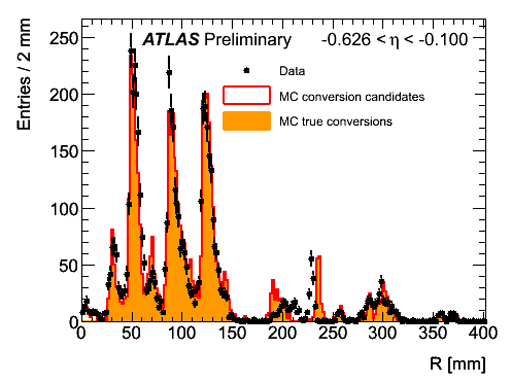
ATLAS e-News
23 February 2011
New, improved simulations!
1 November 2010

The radial distribution of the reconstructed conversion vertices in the barrel tracker sections as obtained with MC09 simulation. The new MC10 simulation is expected to give a better description of the data, thanks to a more accurate understanding of the inner detector material.
At the end of September, a new ATLAS Monte Carlo (MC) production started, the so-called MC10 campaign, thanks to a summer full of physics validation and expert interventions. This includes a re-generation of events using improved tunings in the generators, which then go through an improved GEANT4 (G4) simulation of the ATLAS detector. The G4 hits produced in this large scale MC production will be processed in the next month as part of the data and MC Autumn re-processing campaign. In case of MC samples, this step includes a more realistic emulation of the various detector electronics (the so-called digitization process), apart from important improvements in the trigger and reconstruction chain.
The new ingredients that have gone into this new MC10 production for the simulation and digitization steps are the result of a coordinated effort among different ATLAS communities to incorporate into our simulation what has been learnt in the last months, by detailed performance and physics analysis of the data collected so far by ATLAS. Pointing to some of these nice improvements, that will hopefully lead us to better physics results in ATLAS, is the aim of this article.
A crucial fix was incorporated in G4 itself to solve a problem of non conservation of energy, observed in some interactions of particles with the detector material. This affected a very small fraction of events, but can still be relevant for various studies such as searches for new physics.
Our understanding of the detector geometry has also got significantly better in all the different systems. In particular, the muon system layout incorporates now additional dead material that should lead to a better description of the measured muon momentum resolution. A big effort has also been put into getting a better description of the inert material of the inner detector, especially in the pixel region and the inner detector rail along the barrel cryostat. Detailed tracking and photon conversions studies have shown that data is now significantly better described by our simulation thanks to the more accurate engineering modelling of these particular Pixel regions. For the calorimeters, an important improvement is that the LAr forward calorimeter is now simulated with a misalignment that should be close to the one observed in data.
In addition to all these important improvements in the ATLAS detector description, the LHC beam spot position was also updated to match that measured in a given data period.
The digitization process has also been tuned to be even more realistic for the various systems. For instance, the readout mode currently used in the silicon pixel and microstrip detectors electronics to take data has now been implemented in the software. For the TRT, the transition radiation model has been tuned to lead to a better description of the data in the low energy region. Quite a lot of sophistication has also been incorporated in the muon detectors digitization, which is now able to access DCS detector conditions such as missing MDT chambers or dead strips in the case of the RPCs, so that they can be masked in our simulation. In addition, the hit and trigger efficiencies of the muon chambers are now also better modelled due to, for instance, the consideration of the measured cross-talk in the trigger chambers.
The detector conditions used in this new simulation (e.g. dead channels, operational voltages, thresholds, etc) have also been updated to correspond to those the detector had or is expected to have during most of the 2010 data taking period. The infrastructure to allow for time dependent conditions in our simulation is now becoming ready but has not been used for this MC10 production.
Simulating the level of pile-up we have in data is also an essential goal of this simulation campaign. The pile-up simulation is done at the digitization step by overlaying the hits from various types of events: signal, minimum bias, cavern background, beam-gas and beam-halo events. The LHC conditions at the start-up, with few bunches far from each other with respect to the ATLAS detectors readout window, led to in-time only pile-up meaning pile-up coming only from the triggered bunch crossing. The situation has now evolved to having trains of bunches with a shorter bunch spacing (currently 150 ns) within a train and a long gap in between trains. Therefore, there are clear effects on the pile-up and hence detector response depending on where in the bunch train the triggering signal event occurs. This specific LHC bunch structure configuration in trains is now also available in our pile-up simulation to reproduce the pile-up conditions of the current ATLAS data.
To conclude, the ongoing MC10 simulation production will bring quite a few improvements with respect to the previous MC09 campaign, leading to a better description of the ATLAS data taken up to the end of 2010 in many different aspects.
 Maria Jose Costa
|